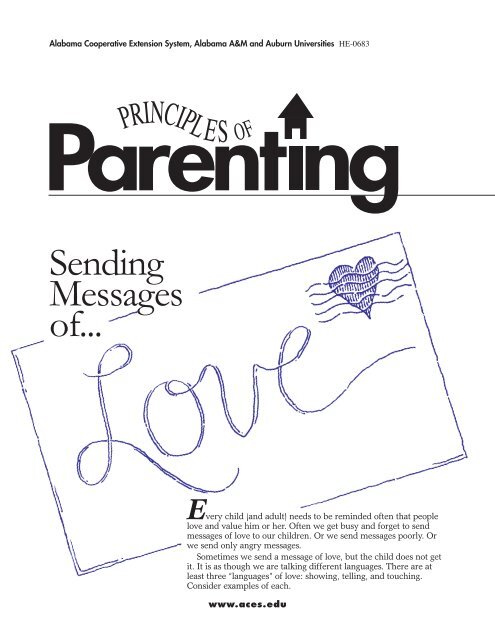Sending Messages...of Love - Alabama Cooperative Extension System
Sending Messages...of Love - Alabama Cooperative Extension System
Sending Messages...of Love - Alabama Cooperative Extension System
Create successful ePaper yourself
Turn your PDF publications into a flip-book with our unique Google optimized e-Paper software.
<strong>Alabama</strong> <strong>Cooperative</strong> <strong>Extension</strong> <strong>System</strong>, <strong>Alabama</strong> A&M and Auburn Universities HE-0683<br />
<strong>Sending</strong><br />
<strong>Messages</strong><br />
<strong>of</strong>...<br />
PRINCIPL E S OF<br />
Every child (and adult) needs to be reminded <strong>of</strong>ten that people<br />
love and value him or her. Often we get busy and forget to send<br />
messages <strong>of</strong> love to our children. Or we send messages poorly. Or<br />
we send only angry messages.<br />
Sometimes we send a message <strong>of</strong> love, but the child does not get<br />
it. It is as though we are talking different languages. There are at<br />
least three “languages” <strong>of</strong> love: showing, telling, and touching.<br />
Consider examples <strong>of</strong> each.<br />
www.aces.edu
A child who likes show-me<br />
messages <strong>of</strong> love may want you<br />
to do things for her. She may<br />
want you to wash the dishes<br />
for her, to buy her a gift, to take<br />
time with her, to take her for<br />
ice cream, or to repair her bike.<br />
A tell-me child wants to hear<br />
words like: “I love you.” “You’re<br />
important to me.” “I love to be<br />
with you.” A touch-me child<br />
may want a parent to hug him,<br />
rock him, cuddle him, or hold<br />
his hand.<br />
That all seems easy enough.<br />
But sometimes the message <strong>of</strong><br />
love does not get through because<br />
we don’t speak the<br />
child’s “language.” For example,<br />
if I send a message <strong>of</strong> love to<br />
my daughter by telling her that<br />
I love her but she wants me to<br />
take time to fix her bike, she<br />
might not get a message <strong>of</strong> love.<br />
She might feel that I don’t really<br />
care. To make it more complicated,<br />
if you have more than<br />
one child, each child probably<br />
has a different way <strong>of</strong> getting<br />
messages <strong>of</strong> love.<br />
How can you effectively<br />
send a message <strong>of</strong> love to a<br />
child? One way is to notice<br />
what your child asks for. Does<br />
he want time, attention, a listening<br />
ear, materials for a<br />
hobby, outings? Another way is<br />
to notice how the child sends<br />
messages <strong>of</strong> love to you and<br />
others. Does she tell you, hug<br />
you, write you notes, clean up<br />
the house? Observing these<br />
things can help you know how<br />
to be more effective at sending<br />
messages to a given child.<br />
You can learn to send the right messages <strong>of</strong> love to your children.<br />
As you read the following list, think <strong>of</strong> each <strong>of</strong> your children and<br />
consider whether this method (or something like it) would be effective<br />
in sending messages <strong>of</strong> love. Write your children’s names in the<br />
blanks to show which messages each child may need to receive.<br />
Child’s name: Ways to send messages <strong>of</strong> love:<br />
Say, “I love you.”<br />
Take a bike ride together.<br />
Hug the child.<br />
Take a nature walk together.<br />
Say, “I sure enjoy being with you.”<br />
Make a trip to the library together. Research a<br />
topic <strong>of</strong> interest to the child. Check out books<br />
for you to read to him or him to read to you.<br />
Say, “I sure am glad you’re my child.”<br />
Work on a craft together: sculpt with clay or<br />
playdough, build with sticks, sew, draw.<br />
Work on a hobby together: writing, stamp<br />
collecting, woodworking.<br />
Give the child a back-rub.<br />
Sit with the child and talk.<br />
Arm-wrestle, thumb-wrestle, or play a game<br />
involving physical exertion. (Be sure the child<br />
has a good chance to win!)<br />
Visit a relative or neighbor.<br />
Thank the child for helping (or trying to<br />
help). Go to a park and swing together.<br />
Build a playhouse with the child, even if it’s<br />
only a sheet thrown over a table. Then play<br />
in the playhouse together.<br />
Have the child help you with grocery shopping.<br />
Have the child sit on your lap or close to you<br />
while reading, talking, or watching television.<br />
Give the child an “Eskimo kiss” (rub noses).<br />
Other:<br />
Children <strong>of</strong>ten enjoy even jobs that seem like “work” if they provide<br />
a special time to be with the parent. For example, a child<br />
might feel important if allowed to go grocery shopping with a parent,<br />
especially if the child is allowed to help.<br />
As you put your children’s names on the ideas above, was one <strong>of</strong><br />
your children very easy to show love to, while another was very<br />
difficult? It’s important to find effective ways <strong>of</strong> showing love to<br />
each <strong>of</strong> your children. The child who is hard to love needs love as<br />
much as any child. Be sure to find effective ways to send love to<br />
that child also.
Schedule special times<br />
with each child.<br />
Some parents schedule dates<br />
or special times with each <strong>of</strong><br />
their children.<br />
Once a month Nancy<br />
would schedule a special<br />
time with each <strong>of</strong> the<br />
children. On Andy’s day<br />
she would take him for a<br />
hike because he loves to<br />
hike. On Emily’s day she<br />
would take her shopping<br />
and for a malt. On another<br />
day she would sew<br />
with Sara. For each <strong>of</strong><br />
the children she scheduled<br />
the things that they<br />
most liked to do.<br />
Of course, once a month is<br />
not <strong>of</strong>ten enough to send a<br />
message <strong>of</strong> love. But it may be<br />
a reasonable schedule for special<br />
times. You may want to use<br />
a calendar to schedule such<br />
special times for each child.<br />
At least once every day we<br />
should find some way <strong>of</strong> sending<br />
a message <strong>of</strong> love to each<br />
child. It may include taking a<br />
few minutes in the evening to<br />
talk with a child about her day.<br />
It may mean inviting your son<br />
to help you cook dinner. It may<br />
be reading a story to your<br />
daughter. But every day the<br />
message <strong>of</strong> love should get<br />
through to each child.<br />
In any family there are times<br />
<strong>of</strong> conflict. It’s not reasonable<br />
to believe that there can be no<br />
differences, arguments, or<br />
fights at home. But while learning<br />
to control the problems, we<br />
can be sure that the message <strong>of</strong><br />
love is still getting through.<br />
Send clear messages.<br />
One <strong>of</strong> the difficulties <strong>of</strong> sending messages <strong>of</strong> love is that we<br />
sometimes send mixed messages.<br />
Tom was visiting with me when he saw his son do<br />
something that upset him. He marched over to the<br />
boy, picked him up, yelled at him, and, when he was<br />
finished with the lecture, said, “And I love you.” I<br />
don’t think the boy got a message <strong>of</strong> love. I think all<br />
he heard was his dad’s anger.<br />
The dad may have thought he had taught his son about responsibility<br />
and still let him know that he loved him. Probably the boy<br />
did not learn anything about responsibility but only learned to be<br />
afraid <strong>of</strong> his father. A parent’s anger can be so frightening to a child<br />
that he does not hear any <strong>of</strong> the words a parent says.<br />
Another difficulty in sending messages to our children is that our<br />
own needs may keep us from seeing our children’s needs.<br />
When Andy earned an award, I told him I was so proud <strong>of</strong> him<br />
that I would take him out to dinner. He said he would rather have<br />
me help him buy a bike. I realized that I was going to take him to<br />
dinner because that’s something I like to do, not because it’s something<br />
Andy likes.<br />
One <strong>of</strong> the challenges in sending effective messages <strong>of</strong> love is<br />
being aware <strong>of</strong> what’s important to the child. Take a few minutes<br />
right now to make a plan <strong>of</strong> how you will send messages <strong>of</strong> love to<br />
each <strong>of</strong> your children in the coming week.<br />
Principles <strong>of</strong> Parenting
Child’s name:<br />
How will I send the message:<br />
Children want to know that they are loved and valued by their parents. We can be effective at sending<br />
messages <strong>of</strong> love if we learn their “language,” send messages regularly, schedule special time with<br />
them, and avoid letting anger block our message.<br />
If you want to learn more . . .<br />
Faber, Adele, and Mazlish, Elaine (1980). How To Talk So Kids Will Listen And Listen So Kids Will Talk. New York: Avon.<br />
Ginott, Haim (1956). Between Parent And Child. New York: Avon.<br />
HE-0683<br />
Ellen Abell, <strong>Extension</strong> Specialist, Associate Pr<strong>of</strong>essor, Human Development and Family<br />
Studies, Auburn University. Originally prepared by H. Wallace Goddard, former <strong>Extension</strong><br />
Family and Child Development Specialist.<br />
For more information, call your county <strong>Extension</strong> <strong>of</strong>fice. Look in your telephone directory under<br />
your county’s name to find the number.<br />
Issued in furtherance <strong>of</strong> <strong>Cooperative</strong> <strong>Extension</strong> work in agriculture and home economics, Acts <strong>of</strong> May 8 and June<br />
30, 1914, and other related acts, in cooperation with the U.S. Department <strong>of</strong> Agriculture. The <strong>Alabama</strong> <strong>Cooperative</strong><br />
<strong>Extension</strong> <strong>System</strong> (<strong>Alabama</strong> A&M University and Auburn University) <strong>of</strong>fers educational programs, materials, and<br />
equal opportunity employment to all people without regard to race, color, national origin, religion, sex, age, veteran<br />
status, or disability.<br />
15M, Reprinted March 2004, HE-0683<br />
© 2004 by the <strong>Alabama</strong> <strong>Cooperative</strong> <strong>Extension</strong> <strong>System</strong>. All rights reserved.
















